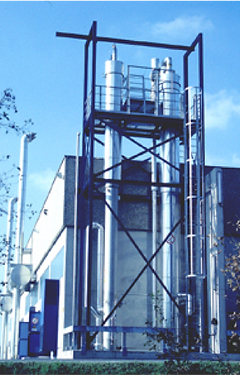
BIOGAS CLEANING & LANDFILL GAS CLEANING
z.B. siloxane (R3Si−[O−SiR2]n−O−SiR3)- & hydrogen sulphide (H2S)-removal
HELASORP®–Process
The HELASORP® process was specially developed for the purification of landfill gases. In this process, all high- and low-molecular organic compounds are removed by absorption. These include
-
chlorinated hydrocarbons
-
aromatic hydrocarbons
-
organic siloxanes
The Advantages of the Process
In addition to reliability, the HELASORP® process is characterised by its insensitivity to dust, water vapour, oil mist, fluctuations in concentration and mass flow as well as to sulphur and its compounds.
Efficiency
The HELASORP® process has an efficiency >98% even at low pollutant concentrations. Changes in the pollutant concentration or fluctuations in the mass flow do not have a negative effect on the efficiency.
Operating costs:
Due to the low temperature level of <90°C in the desorber and the low gas-side pressure loss of <15mbar in the absorber, the operating costs are extremely low.
Hydrogen Sulphide Removal
With the aid of a downstream absorber with an iron hydroxide or activated carbon adsorber, sulphur compounds such as hydrogen sulphide (H2S) can also be separated from the gas.



GAS CLEANING WITH HERBST - BIOFILTER
Herbst Umwelttechnik offers four processes for hydrogen sulphide separation

Der Herbst Biofilter - Legende
-
Rohgaseintritt
-
Vorabscheider
-
Biologisch aktive Schüttung
-
Reingasaustritt
-
Gehäuseisolation

Herbst-Biofilter — for large volume flows, especially in sewage treatment plants.
With the help of microorganisms (thiobacilli), the H2S is degraded in the Herbst Biofilter on an inorganic carrier material. This produces sulphurous acid and water. The anaroganic debris on which the thiobacilli live is continuously neutralised with sodium hydroxide solution. This achieves the desired stable process control. The internals in the Herbst Biofilter are wear-free and never have to be replaced.
In situ H2S-removal
Methane bacteria are sensitive to H2S, which inhibits the formation of biogas. By using iron hydroxide, the H2S is separated directly in a biogas plant or in a digestion tower. Herbst Umwelttechnik offers complete silo systems for iron hydroxide as well as dosing and suspension reactors with which the iron hydroxide can be easily introduced into the process.
Adsorptive H2S separation
To protect the gas engine, the H2S is separated adsorptively before combustion. Iron hydroxide is used as adsorbent. By adding atmospheric oxygen to the adsorber, the iron hydroxide charge is regenerated until the elementary sulphur concentration has reached its maximum value, approx. 300 g sulphur per kilogram of adsorbent. The loaded iron hydroxide can be continuously removed from the adsorber and the unloaded iron hydroxide introduced.
H2S Mini-adsorber— Processing of fresh air for ventilation of buildings
Specially developed for the treatment of slightly contaminated fresh air, the H2S Mini-adsorber allows the removal of harmful and aggressive hydrogen sulphide even in low concentrations in a cost-effective and reliable manner. Common areas of application are industrial areas, water treatment plants and biogas plants in the vicinity of which the air is often contaminated with hydrogen sulphide. If this air is used for the ventilation of buildings, health problems can occur and sensitive electronic components can be damaged. The H2S Mini-adsorber prevents that.
Design of the Herbst-Biofilter
The microorganisms in the Herbst-Biofilter settle on a special inorganic HELATORP® carrier material through which the exhaust air to be cleaned flows. The high efficiency of the Herbst-Biofilter, combined with a compact design, is achieved through optimal process performance. This promotes the growth of microorganisms by adding nutrients. At the same time, the internal operating parameters such as population density, pH values, nutrient supply and degree of pollution are adapted to each individual case. Despite the intensive biological degradation in the Herbst-Biofilter, the HELATORP® carrier material is not subject to aging. In addition to the high degradation performance, the Herbst-Biofilter has the advantage over conventional biofilters that the inorganic HELATORP® filling never has to be changed.
Fields of application
• Exhaust gas purification
• Odor elimination
• Stripping air cleaning
• remediation of contaminated sites
Degradable pollutants
• Hydrogen sulphide
• Vinyl chloride and partially
• Odours


SEPARATION OF SILANES AND SILOXANES FROM THE GAS PHASE
The Problem
Silanes and siloxanes are chemical compounds based on silicon, which are used in many areas of industry with an increasing tendency. The various silicon compounds reach sewage treatment plants or landfills via the waste path.
In more modern waste processing plants, the biogas or landfill gas produced is used by gas engines to generate electrical energy. During combustion in the gas engine, mineral silicon dioxide deposits are formed from the siloxanes, which lead to serious damage. In many cases, these damages call into question the economic efficiency of biogas or landfill gas utilisation.
The solution
Herbst Umwelttechnik GmbH offers several processes for the separation of siloxane compounds from gases. The selection of the recommended separation process depends on the gas volume flow, the gas composition and the siloxane concentration.
Our separation processes:
-
Condensation of the siloxanes using gas cooling with downstream activated carbon reactor
-
adsorptive siloxane deposition with iron hydroxide
-
Absorptive siloxane separation with our HELASPROP® process



